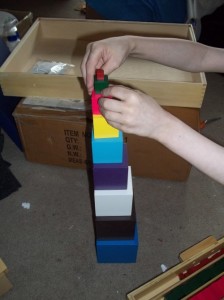Montessori and Common Core Alignment
Common Core is the buzzword of late. This site does not intend to get into the positives or negatives of these standards. Simply to share some information for the Montessori homeschooling community. This article is not particularly pertinent to the Common Core; indeed it can be applied to any of the local educational requirements (public school requirements) that we have around the world.
The stance of AMI Montessori is for the 3rd and 6th year children in Montessori to be made aware of any local education requirements and take it upon themselves to assure they have met the requirements.
And what does that mean in practice?
There may be an area of study (such as local national history) that the child has not yet embarked upon, but the child will see this on the local educational requirements (public school requirements – typically the local state standards) and will develop a study of his/her own (with as much or as little teacher guidance as needed). On very rare occasions a teacher should create a material to help a child learn something on the standards – however, it is always best to start with trusting the child and work from there, providing as much assistance as needed, and only as much assistance as needed.
- where does this requirement align with a current presentation, for which said requirement could be a natural extension – guide the child that direction with words, or provide cue cards/work
- check the albums to see if there is already some guidance there for how to go about a particular type of requirement
- consider particular key experiences that will entice or enhance interest
- do the study with the child
- most importantly, show the 3rd and 6th grade standards to the 3rd and 6th year students and see what creative ideas they come up with to master a particular requirement – or to prove they already know it.
Please note: while we typically post the 3rd and 6th grade requirements for just those children and this is typically found to cover most areas of study, it is a point of interest to look back at years 1, 2, 4, and 5, where a local educational standard may have a particular area of study being covered, such as local national history, or a specific area of science. This note applies more to non-common-core standards, of which a few remain in the United States; as well as areas outside of the United States. Add these particular topics into the appropriate 3rd and 6th mix, if they are not thoroughly covered by the Montessori presentations already; or these may be areas that a teacher does indeed develop materials as a typical part of the classroom experience.
Common Issues:
A common danger with any of the standards is to align Montessori to the Standards, rather than pointing out where the standards are already fulfilled within the normal Montessori experience; then noting what the local educational authority requires that are not specifically met by the core Montessori experience.
For MOST children in a fully functional Montessori environment, they will have met many of these standards anywhere from a year to 4 or even 5 years “ahead” of schedule.
This does not mean we “dumb-down” Montessori and hold off several years to give a presentation just because the public school children don’t learn it until then… For example, there is a natural window for learning to read, so use it! Don’t wait until it’s a requirement!
Another common danger is to look at the standards (common core or otherwise) and simply plug in which materials help the child meet this standard, with no or very little care to noting in which year they likely met that requirement, thus causing it to appear that a child will work with those materials in that year. For example, a 3rd grade chart of the Common Core standards is presented, with a column indicating the materials utilized to meet each of those standards; but some of that work the child had already done back in kindergarten or 1st grade. It is handy for the child to see which materials he will need to get out to double-check he has the requirement met,
Results of the Common Issues:
And this is how we come to have a variety of Montessori albums with work placed at varying locations – some albums have been adapted over time in response to the above experiences, among others. Keys of the Universe is largely AMI and trusts Dr. Maria Montessori’s own observations, as well as my own observation and work over the last umpteen years confirming her observations of natural windows of learning opportunities. If I find a child needs more time, he has more time; if I find a child is ready to just fly ahead, I have the tools on hand to do so. Neither I nor the child are bogged down by teacher-presentations that are not “keys” to the child’s educational and life experience, thus he has time to pursue his own interests in depth and still practice responsibility assuring those local educational requirements are fulfilled.
We must never teach TO the standards; we must provide a rich experience for the children that they can fill in those needed requirements at the appropriate times, naturally and gracefully because we have otherwise provided such a fulfilling experience that they can take on any challenge we send their way!
What We Actually Provide the Child:
What we provide the child is not going to perfectly match what we provide adults, authorities, etc. – they need the background and other information. The children just need the facts.
In actual practice, we will take the 3rd grade and 6th grade standards; organize them so there is a list of easily understand “requirements” in one column (delete all the philosophy, background and other information that comes with typical files on the standards) – and perhaps a second column indicating that “you’ve probably already done this, but review if needed.”
(add in any specific areas of study from the two grades lower – such as in our area, certain areas of science are covered by all the schools in the same grade)
Let the children come up with the materials they will need to use.
Let the children come up with the projects and the desired method of proof of learning.
Think of the whole thing as more of a check-point; a touch-stone; NOT a checklist. This is hard to do in practice by us adults, but is easy for the children if we LET it be easy for the children 😉
(by “normal” here I mean the observations and discoveries made by Dr. Maria Montessori in her time and with the children in all the various countries she observed; all of which observations apply to all children today)




